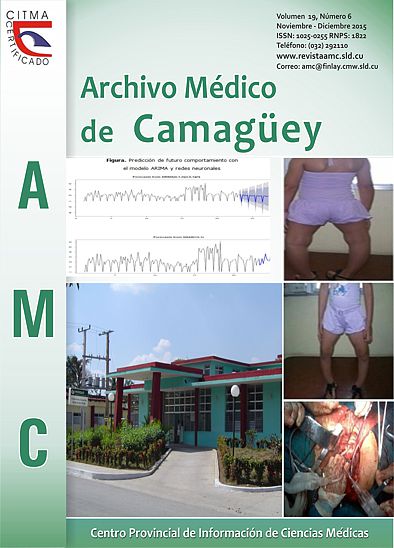Fascitis necrotizante
Resumen
RESUMENFundamento: fascitis necrotizante es en conjunto la infección quirúrgica más desafiante a la que se enfrentan los cirujanos. El manejo complejo se debe a la combinación de dificultades para el diagnóstico y el tratamiento.
Objetivo: actualizar y sistematizar los conocimientos sobre una enfermedad devastadora que es un reto para los cirujanos.
Métodos: se realizó una revisión de la literatura de los últimos cinco años. Se incluyeron seis artículos originales, nueve reportes de caso y siete revisiones bibliográficas. Se insistió en la clasificación, patogenia, diagnóstico y tratamiento.
Desarrollo: es una infección progresiva, poco común y letal que puede afectar cualquier parte del cuerpo, pero es más frecuente encontrarla en las extremidades, en especial en las piernas. En su mayoría es polimicrobiana y se caracteriza por afectar la fascia superficial, tejido subcutáneo, grasa subcutánea con nervios, arterias, venas y fascia profunda. El cuadro avanza de forma rápida en el curso de varios días. El diagnóstico es en principio clínico. La microbiología, la radiografía y las imágenes de resonancia magnética son los estudios complementarios más usados. El tratamiento comprende medidas de soporte hemodinámicas, un extenso desbridamiento quirúrgico precoz y uso de antimicrobianos, además de los cuidados generales.
Conclusiones: la fascitis necrotizante es una enfermedad rara pero potencialmente letal que puede afectar cualquier parte del organismo. Se debe tener alto grado de sospecha debido a la pausa de las manifestaciones cutáneas específicas. Los antecedentes y el cuadro clínico son los elementos claves para el diagnóstico. La cirugía inmediata agresiva es obligatoria. A pesar de todas las medidas, la mortalidad se mantiene muy elevada.
Background: necrotizing fasciitis is the most challenging surgical infection that surgeons face. The complex management is due to the combination of difficulties for the diagnosis and treatment.
Objective: to update and systematize knowledge about a devastating disease that is a challenge for surgeons.
Methods: a review of the literature from the last five years was made. Six original articles, nine case reports and seven bibliographic reviews were included. There was particular attention to classification, pathogeny, diagnosis and treatment.
Development: necrotizing fasciiatis is an uncommon, progressive, deadly infection that can affect any part of the body but it is more frequent in extremities, especially the legs. It is mostly polimicrobial and affects the superficial fascia, the subcutaneous tissue, the subcutaneous fat with nerves, arteries, veins and the deep fascia. The infection progresses rapidly in few days. Microbiology, radiography and magnetic resonance imaging are the most used complementary studies. The diagnosis is mainly clinical. The treatment includes support hemodynamic measures, an extensive early surgical debridement and the use of antimicrobials, besides the general care.
Conclusions: necrotizing fasciiatis is an uncommon but potentially deadly disease that can affect any part of the organism. A great level of suspicion is needed due to the pause of the specific cutaneous manifestations. The antecedents and the clinical manifestations are key elements for the diagnosis. Immediate aggressive surgery is compulsory. In spite of all the measures taken, mortality is really high.
Descargas
Descargas
Publicado
Cómo citar
Número
Sección
Licencia
La Revista Archivo Medico Camagüey, ofrece de forma inmediata después de ser indexada en el Proyecto SciELO; acceso abierto al texto completo de los artículos bajo el principio de hacer disponible y gratuita la investigación para favorecer el intercambio del conocimiento global y coadyuvar a una mayor extensión, publicación, evaluación y uso extensivo de los artículos que se exponen pudiendo ser utilizados, sin fines comerciales, siempre y cuando se haga referencia a la fuente primaria.
Carta De Declaración De Autoría u Derechos De Autor(a)
Conflictos de intereses: los autores deberán declarar de forma obligatoria la presencia o no de conflictos de intereses en relación con la investigación presentada. (Descargar Plantilla para declarar confictos de intereses)
La Revista Archivo Médico Camagüey se encuentra bajo una
Licencia Creative Commons Reconocimiento-NoComercial 4.0 International (CC BY NC 4.0).
Esta licencia permite a otros distribuir, mezclar, ajustar y construir a partir de su obra, incluso con fines comerciales, siempre que le sea reconocida la autoría de la creación original. Esta es la licencia más servicial de las ofrecidas. Recomendada para una máxima difusión y utilización de los materiales sujetos a la licencia. La licencia completa puede consultarse en: https://creativecommons.org/licenses/













